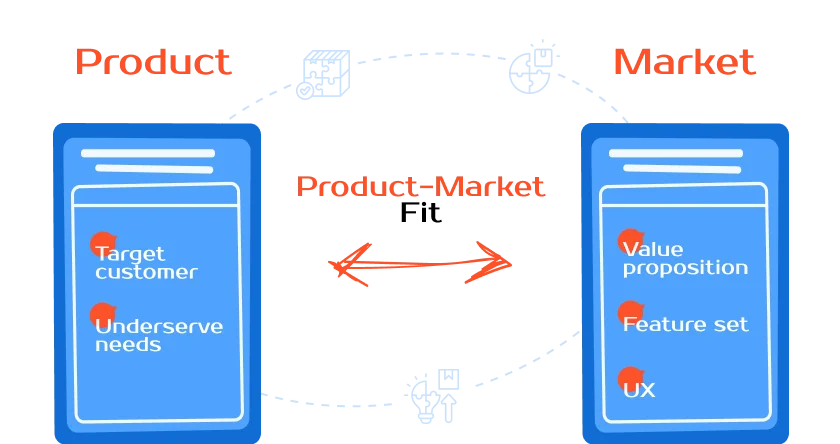Product-Market Fit: A Comprehensive Guide for Startups and Beyond
Published:
August 9, 2025

Understanding why some products thrive while others struggle often comes down to one key factor: product-market fit. Whether you're launching a startup or refining an existing solution, achieving product-market fit is what separates sustainable growth from costly guesswork. This guide breaks down what it means, why it matters and how to find and measure it with clarity and precision.
What Is Product-Market Fit?
Product-market fit is a business stage where a product effectively meets the needs of a specific target audience and demonstrates clear demand. It is characterized by strong customer engagement, repeated use and positive feedback, indicating that the product solves a relevant problem in the market.
Reaching this stage is essential before scaling operations or investing in growth strategies, as it confirms that the offering delivers real value and has long-term viability.
Why Product-Market Fit Matters?
Product-market fit is the foundation for sustainable growth because it validates that a solution aligns with a real market need. When demand is genuine customers adopt the product without heavy incentives, retention rates climb and referrals appear organically. This organic traction lowers acquisition costs and raises lifetime value, improving cash flow and profitability.
For startups such metric signals that scarce resources are being applied to a concept with proven potential rather than an untested hypothesis. Teams can prioritise feature refinement and operational efficiency instead of repeatedly pivoting, which reduces burn rate and shortens the path to breakeven.
Investors view product-market fit as tangible proof of market traction, so companies that achieve it gain stronger negotiating positions for funding. The confidence it provides helps leaders forecast revenue more accurately, plan hiring, scale sales and support infrastructure with less risk.
How to Find Product-Market Fit?
Finding product-market fit is a critical milestone for any business. Achieving it requires a systematic approach that combines market research, product development, customer feedback and performance analysis:
- Define the target market. Identify a specific audience segment with a well-defined problem. Use demographic, behavioral and psychographic data to create detailed customer profiles. Focus on segments with clear needs, willingness to pay and limited satisfaction from existing solutions.
- Understand customer needs. Conduct interviews, surveys and competitive research to gather qualitative and quantitative insights. Identify the core pain points customers face, what solutions they currently use and what they value most in a product.
- Develop a clear value proposition. Craft a concise statement that explains how your product solves the target customer's problem better than alternatives. Ensure this message is aligned with customer priorities and market gaps.
- Build and launch a minimum viable product (MVP). Create a functional version of the product with only essential features needed to deliver value. Launch it to a limited audience to test assumptions and collect early feedback with minimal investment.
- Measure user engagement and satisfaction. Track metrics such as user retention, activation rate, net promoter score (NPS), customer lifetime value and churn. Analyze usage patterns to determine if customers are consistently using the product and finding value in it.
- Collect and implement feedback. Engage users through interviews, support tickets and behavior tracking. Prioritize improvements based on recurring issues or suggestions. Iteratively adjust the product to better meet user expectations.
- Test pricing and business model. Evaluate whether the product delivers enough perceived value to justify its price. Test different pricing models or packages to find a balance between user acquisition and revenue potential.
- Validate with market signals. Including organic user growth, word-of-mouth referrals, low churn, high retention and increased willingness to pay. If demand continues to grow with minimal push, the market fit is likely achieved.
Scale gradually and strategically. Once fit is confirmed, begin expanding marketing, sales and support infrastructure. Invest in automation, talent and processes to sustain growth without compromising product quality or customer satisfaction.
Need help improving your business? Let’s talk
How to Measure Product-Market Fit?
While there is no single metric, a combination of quantitative and qualitative indicators helps determine whether product-market fit has been achieved.
- Customer Retention and Engagement. High retention rates suggest that users find ongoing value in the product. Look for consistent usage over time, frequency of logins or transactions and cohort analysis to see if early users continue engaging.
- Net Promoter Score (NPS). This measures customer satisfaction by asking how likely users are to recommend the product. An NPS above 50 often indicates strong loyalty and alignment with customer needs.
- User Growth and Organic Acquisition. If the product is spreading through word-of-mouth without heavy marketing, it’s a sign of strong demand. Rapid growth from referrals or direct visits shows the product solves a valuable problem.
- Customer Feedback and Sentiment. Monitor qualitative input from support tickets, reviews and surveys. Enthusiastic feedback, feature requests and emotional buy-in are positive signs of product-market alignment.
- Churn Rate. A low churn rate means users are satisfied and not abandoning the product. This is especially critical in subscription or usage-based models.
- Conversion Metrics. Track how many users move from trial to paid plans, or from visitors to active users. High conversion rates indicate a compelling value proposition.
Product-Market Fit Examples
Several well-known companies provide clear demonstrations of product-market fit in action. Below are two distinct cases that illustrate how aligning a product with real market demand can lead to rapid adoption and scalable success:
Example 1: Slack
Slack achieved product-market fit by addressing a specific pain point for software development and project teams: fragmented communication. Before Slack, teams relied on a mix of email, chat tools and project trackers. Slack unified messaging, file sharing and integrations into one platform, improving workflow and transparency. As teams adopted it, usage expanded organically across departments and companies, confirming strong market demand.
Example 2: Airbnb
Airbnb found product-market fit by solving the lack of affordable, local lodging for travelers and helping homeowners monetize unused space. Initially targeting budget-conscious travelers during large events, the platform grew as hosts and guests found mutual value. The high rebooking rate, host satisfaction and growing supply in diverse markets signaled that Airbnb had matched its product with an underserved market need.
What Comes First: Positioning or Product-Market Fit?
Product-market fit typically comes before formal positioning.
Product-market fit is about discovering whether your product solves a real problem for a specific group of users. It involves testing different features, audiences and value propositions to find what resonates. At this stage, flexibility is key, as the product may change significantly based on user feedback.
Positioning comes once there is clear evidence of fit. It defines how you communicate your product’s value, who it is for and why it’s better than alternatives. Without product-market fit, positioning is built on assumptions rather than validated insights, making it less effective.
In short, product-market fit is the foundation. Positioning builds on that foundation to shape perception, differentiate in the market and drive growth.





